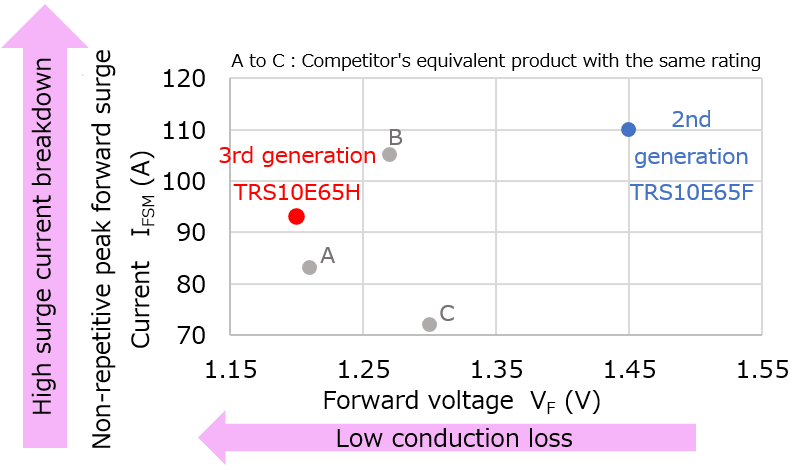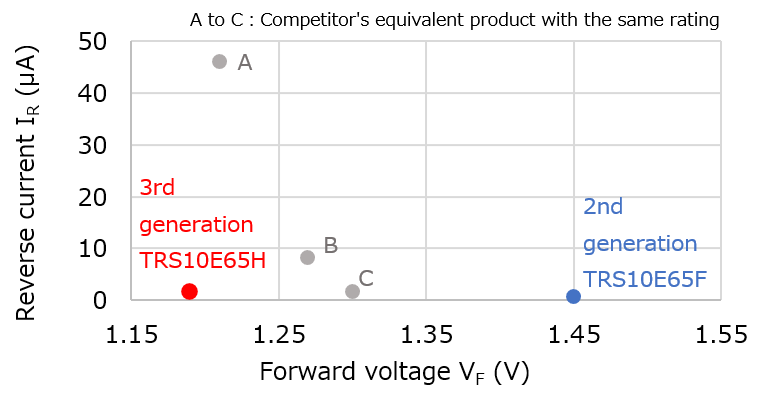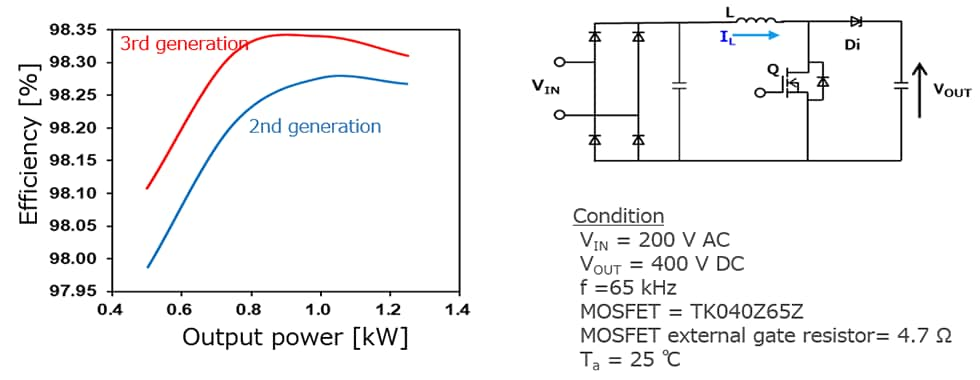- General Top
- SEMICONDUCTOR
- STORAGE
- COMPANY
-
My ToshibaSemicon
- Semiconductor Top
-
ApplicationsAutomotive
Body Electronics
xEV
In-Vehicle Infotainment
Advanced Driver-Assistance Systems (ADAS)
Chassis
IndustrialInfrastructure
BEMS/HEMS
Factory Automation
Commercial Equipment
Consumer/PersonalIoT Equipment
Healthcare
Wearable Device
Mobile
Computer Peripherals
-
ProductsAutomotive Devices
Discrete Semiconductor
Diodes
Transistors
Logic ICs
Analog Devices
Digital Devices
Wireless Devices
※
: Products list (parametric search)
Power SemiconductorsSiC Power Devices
※
: Products list (parametric search)
Isolators/Solid State RelaysPhotocouplers
Digital Isolators
Solid State Relays
Fiber Optic Transmitting Modules
※
: Products list (parametric search)
MOSFETsIGBTs/IEGTsBipolar Transistors※
: Products list (parametric search)
Diodes※
: Products list (parametric search)
MicrocontrollersMotor Driver ICsIntelligent Power ICs※
: Products list (parametric search)
Power Management ICsLinear ICs※
: Products list (parametric search)
General Purpose Logic ICsLinear Image SensorsOther Product ICsOther Product ICs
※
: Products list (parametric search)
-
Design & Development
Design & Development
Innovation Centre
At the Toshiba Innovation Centre we constantly strive to inspire you with our technologies and solutions. Discover how to place us at the heart of your innovations.
-
Knowledge
Knowledge
Highlighted Topics
Further Materials
Other
- Where To Buy
- Part Number & Keyword Search
- Cross Reference Search
- Parametric Search
- Stock Check & Purchase
This webpage doesn't work with Internet Explorer. Please use the latest version of Google Chrome, Microsoft Edge, Mozilla Firefox or Safari.
require 3 characters or more. Search for multiple part numbers fromhere.
The information presented in this cross reference is based on TOSHIBA's selection criteria and should be treated as a suggestion only. Please carefully review the latest versions of all relevant information on the TOSHIBA products, including without limitation data sheets and validate all operating parameters of the TOSHIBA products to ensure that the suggested TOSHIBA products are truly compatible with your design and application.Please note that this cross reference is based on TOSHIBA's estimate of compatibility with other manufacturers' products, based on other manufacturers' published data, at the time the data was collected.TOSHIBA is not responsible for any incorrect or incomplete information. Information is subject to change at any time without notice.
require 3 characters or more.
3rd generation SiC Schottky barrier diode
The 3rd generation Silicon Carbide (SiC) Schottky barrier diode (SBD) has a lineup of seven products parts of TO-220-2L package and 5 products of DFN8×8 package. It adopts the new schottky metal [Note 1], and it is equipped with 3rd generation SiC SBD chip, which optimized junction barrier schottky (JBS) [Note 2] structure of 2nd generation. As a result, we have achieved industry-leading lowest forward voltage 1.2 V (Typ.) [Note 3], which is 17 % lower than that of the 2nd generation 1.45 V (Typ.). Our 3rd generation SiC SBD contribute to lower power consumption and higher output of various equipment, which is used for switching power supply application mainly, by the following features.
Features of the 3rd generation SiC SBD
1. VF × QC [Note 5] trade-off improvement
We have improved the Forward voltage (VF) and the Total capacitive charge (QC) trade-off by adopting the new Schottky metal.
Below the comparison evaluation results using representative samples of 650V / 10A / TO-220-2L rating products of our 3rd and 2nd generations and other competitors products [Note 3] and 1200V / 20A / TO-247-2L rating produts of our 3rd and other competitors products [Note 4] .
![V<sub>F</sub> × Q<sub>C</sub> <sup>[note5]</sup> trade-off improvement](/content/dam/toshiba-ss-v3/master/en/semiconductor/product/diodes/articles/3rd-generation-sic-schottky-barrier-diode_features_1_en.png)
We have achieved higher Non-repetitive peak forward surge current (IFSM) by improving the conventional JBS structure.

3. Low Reverse current (Leakage current)
We could get lower Reverse current (IR) by adopting JBS structure even through lower Forward voltage.

Efficiency improvement of power supply
On our Boost PFC test circuit, our 3rd generation SiC SBD achieved approximately 0.1 % efficiency improvement against 2nd generation at the 800W output condition.

(Toshiba internal comparison, as of November 2021)
[Note 1] In Schottky barrier diodes, it is the metal that is joined to the semiconductor.
[Note 2] JBS: It is a structure which the p region is embedded in the n-regions of the semiconductor surface. When the reverse bias voltage increases, the depletion region extends between the p and n- regions thereby reducing laekage current.
[Note 3] As of June 2023.
[Note 4] As of September 2024.
[Note 5] VF × QC: Forward voltage × total capacitance charge, which is an index of the loss performance of SiC SBD. When you compare with the same current rating products, the smaller VF × QC achieves lower loss.
SiC schottky barrier diodes
Related information
See the following pages for various applications.
See the following pages for Application Notes.
FAQ
See the following page for frequently asked questions.
Queries about purchasing, sampling and IC reliability
Stock Check & Purchase
require 3 characters or more.

